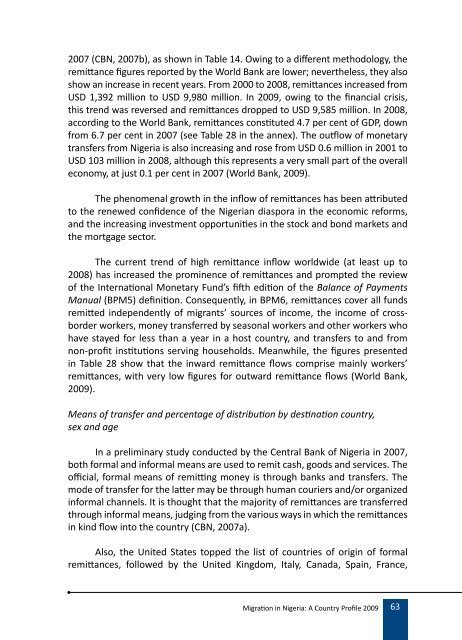Migration Profile on Nigeria - IOM Publications - International ...
Migration Profile on Nigeria - IOM Publications - International ...
Migration Profile on Nigeria - IOM Publications - International ...
You also want an ePaper? Increase the reach of your titles
YUMPU automatically turns print PDFs into web optimized ePapers that Google loves.
2007 (CBN, 2007b), as shown in Table 14. Owing to a different methodology, the<br />
remittance figures reported by the World Bank are lower; nevertheless, they also<br />
show an increase in recent years. From 2000 to 2008, remittances increased from<br />
USD 1,392 milli<strong>on</strong> to USD 9,980 milli<strong>on</strong>. In 2009, owing to the financial crisis,<br />
this trend was reversed and remittances dropped to USD 9,585 milli<strong>on</strong>. In 2008,<br />
according to the World Bank, remittances c<strong>on</strong>stituted 4.7 per cent of GDP, down<br />
from 6.7 per cent in 2007 (see Table 28 in the annex). The outflow of m<strong>on</strong>etary<br />
transfers from <strong>Nigeria</strong> is also increasing and rose from USD 0.6 milli<strong>on</strong> in 2001 to<br />
USD 103 milli<strong>on</strong> in 2008, although this represents a very small part of the overall<br />
ec<strong>on</strong>omy, at just 0.1 per cent in 2007 (World Bank, 2009).<br />
The phenomenal growth in the inflow of remittances has been attributed<br />
to the renewed c<strong>on</strong>fidence of the <strong>Nigeria</strong>n diaspora in the ec<strong>on</strong>omic reforms,<br />
and the increasing investment opportunities in the stock and b<strong>on</strong>d markets and<br />
the mortgage sector.<br />
The current trend of high remittance inflow worldwide (at least up to<br />
2008) has increased the prominence of remittances and prompted the review<br />
of the Internati<strong>on</strong>al M<strong>on</strong>etary Fund’s fifth editi<strong>on</strong> of the Balance of Payments<br />
Manual (BPM5) definiti<strong>on</strong>. C<strong>on</strong>sequently, in BPM6, remittances cover all funds<br />
remitted independently of migrants’ sources of income, the income of crossborder<br />
workers, m<strong>on</strong>ey transferred by seas<strong>on</strong>al workers and other workers who<br />
have stayed for less than a year in a host country, and transfers to and from<br />
n<strong>on</strong>-profit instituti<strong>on</strong>s serving households. Meanwhile, the figures presented<br />
in Table 28 show that the inward remittance flows comprise mainly workers’<br />
remittances, with very low figures for outward remittance flows (World Bank,<br />
2009).<br />
Means of transfer and percentage of distributi<strong>on</strong> by destinati<strong>on</strong> country,<br />
sex and age<br />
In a preliminary study c<strong>on</strong>ducted by the Central Bank of <strong>Nigeria</strong> in 2007,<br />
both formal and informal means are used to remit cash, goods and services. The<br />
official, formal means of remitting m<strong>on</strong>ey is through banks and transfers. The<br />
mode of transfer for the latter may be through human couriers and/or organized<br />
informal channels. It is thought that the majority of remittances are transferred<br />
through informal means, judging from the various ways in which the remittances<br />
in kind flow into the country (CBN, 2007a).<br />
Also, the United States topped the list of countries of origin of formal<br />
remittances, followed by the United Kingdom, Italy, Canada, Spain, France,<br />
<str<strong>on</strong>g>Migrati<strong>on</strong></str<strong>on</strong>g> in <strong>Nigeria</strong>: A Country <str<strong>on</strong>g>Profile</str<strong>on</strong>g> 2009<br />
63

















